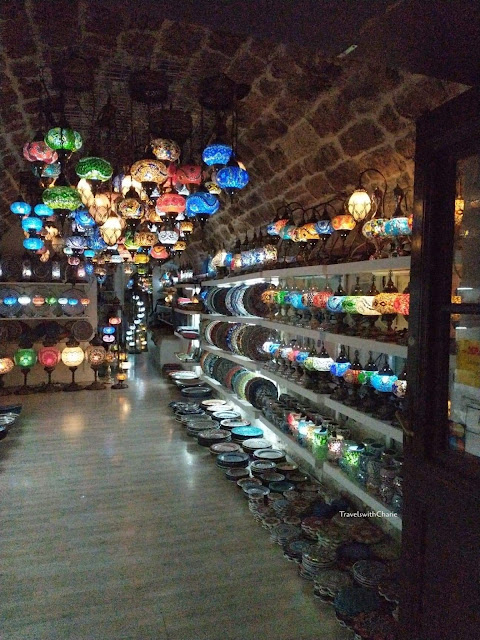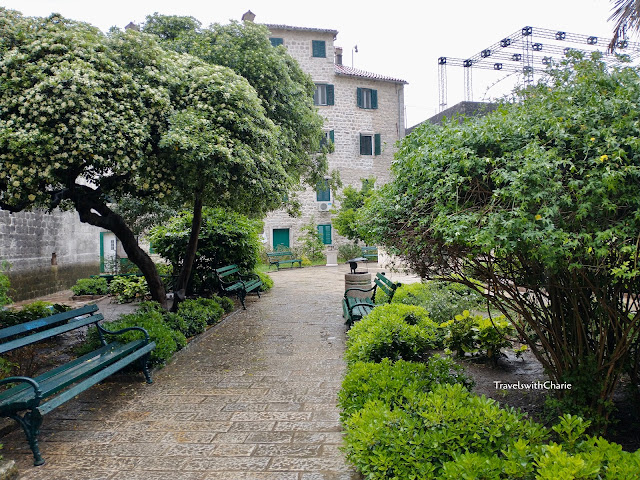Not all travel days go as planned. We can choose to be miserable or we can go with the flow even if that means we have to walk in the rain and take poor resolution photos. So it was on the day I went to Montenegro last May. It started to shower early in the morning and lingered till we got to Kotor when the sky decided to let go and rain came down in buckets as I entered the gate to the old town. I was wearing a raincoat and my clothes were dry but my spirit was broken and all I wanted to do was go back to Cavtat where the sun was shining and the sea was so blue and calm.
Whining aside, there’s so much to appreciate in Kotor and seeing this store with the colorful lamps made me think of Morocco and the bazaars of the Orient. It lifted my spirit.

What is striking about Kotor are the little Orthodox churches that are tucked into tiny alleys. I wondered how many people could fit in there at one time.
Everything about the architecture, the cobble stone alleys, the passages that lead you astray but yet, you are never lost, enchanted this first-time visitor.
The Orthodox Church of St. Luke is one of the oldest buildings in the country. It dates back to 1195.
Beautiful iconostasis inside an Orthodox church.
And this door just drew me with its interesting bas reliefs and the stories it tells.
Cathedral of St. Tryphon
St. Tryphon is the patron saint of Kotor. His relics are kept in this Cathedral which was consecrated in 1166. You can see the dates 1166 and 2016 etched beneath the arched windows flanking the central balcony. 2016 denotes the completion of the careful restoration of this Romanesque church which was heavily damaged in the earthquakes of 1667 and 1979. Notice the unequal Baroque style belltowers that were added much later and left one tower unfinished. You can go up to the balcony above the main portal and have a fine view of Kotor. *There is a small fee to enter the church.

I love the simplicity of the interior and the peace and quiet despite the arrival of tourists. It felt good to stay and pray for awhile and to get away from the rain and the overwhelming number of visitors I encountered while walking around town. Found out later it was a holiday in Montenegro and many Montenegrins were enjoying their long weekend.
The walls around Kotor were built during the Venetian Republic occupation from 1420 to 1797. It’s so well preserved that you can still see its extension stretching above the city to another fortress at the top of the hill. These fortifications are a UNESCO World Heritage site under “Venetian works of defense between the 16th and 17th centuries: Stato da Terra and Western Stato da Mar”. It’s possible to climb up to San Giovanni Fortress and depending on the route you take, you may have to pay an entrance fee.
Fortifications aside, the old town of Kotor is a UNESCO World Heritage site.
The Scurda River flows past Kampana Tower and Citadel as it meanders to the bay. The dome of St. Nikolas Church rises above the walls as clouds brood over the city and shrouded the mountains from view.
Would have loved to sit at this tiny park beside the River Gate had it not been raining. Next time.
These flowers at the Food Market brightened the moody day. It’s right across the waterfront and you can sit outside and enjoy your food purchases with a view of the bay.
*****
After
This beautiful main square (Trg Od Oružja) is less busy after the initial swarm of visitors found a table at one of the terrace restaurants.
Kotor’s Clock Tower has been telling time since 1602. It has survived several earthquakes through the centuries. Tip: when a local asks you to meet him/her at the clock tower, this is it!
Sea Gate (Western Gate)
Visitors enter the old town through the Sea Gate. *There is a small entrance fee and you will receive a map that details the places of interest within the walls. Note the inscription on the plaque directly above the gate. It says 21 XI 1944, the date when Montenegro was liberated from the Nazis. Above the plaque is an inscription from Josip Broz Tito, former President of Yugoslavia. It says, “We will not give our own to others”. On the pediment above the inscription is the winged lion, the symbol of Kotor.
How to get there:
I took a day tour to Montenegro with Super Tours from Cavtat in Croatia. The tour is called the Best of Montenegro Day Trip and we stopped in Perast, Kotor, and Budva. We had time to see Our Lady of the Rocks island on our own. This is a big bus tour and there were about 36 people in the bus. At €45, this was a bargain. Super Tours can be reached at supertours.eu.
Images by TravelswithCharie


















